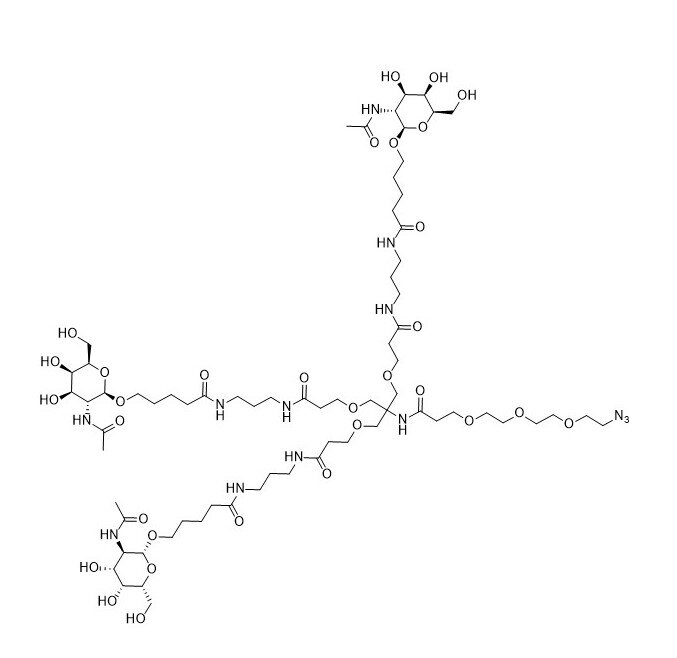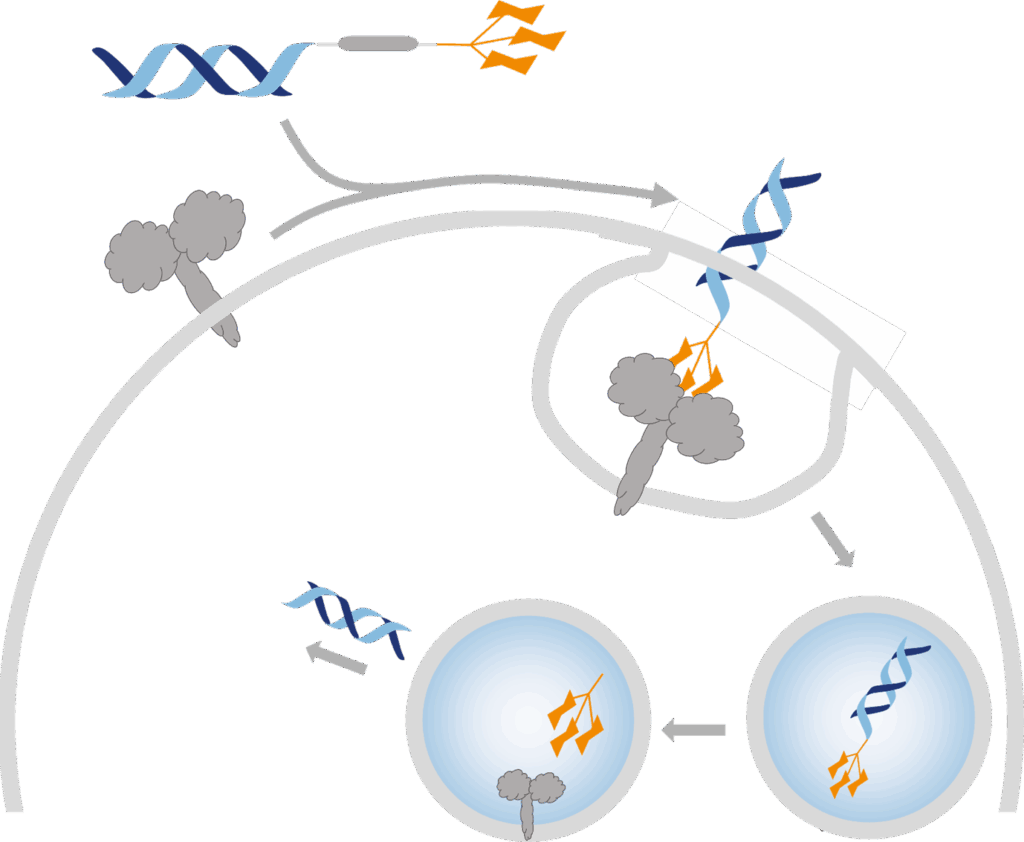Tri-β-GalNAc-PEG3-Azide
Clickable Tri-GalNAc identifier for target delivery

| Size | Catalog No. | Price |
|---|---|---|
| 5 mg | BCFA-246-5 | € 450,00 |
| 10 mg | BCFA-246-10 | € 760,00 |
Chemical Properties
-
Molecular Formula
C70H125N13O31
-
Shelf Life
12 months unopened after receipt
-
Storage Conditions
-20 °C, dark
-
Molecular Weight
1644.8 g/mol
-
Purity
≥ 95% (HPLC)
-
Physical State
white solid
-
CAS Number
2925590-71-0
-
Additional name
Tri-beta-GalNAc-PEG3-Azide, Tri-GalNAc-PEG3-Azide, Tri-β-GalNAc-PEG3-N3, (β-D-GalNAc)3-PEG3-N3, (β-D-GalNAc-sp)3-NHC(O)-PEG3-N3
-
Solubility
H2O, DMSO
-
Preparation/Handling
For a 10 mM solution add 304 μL to 5 mg.
For a 10 mM solution add 608 μL to 10 mg.
Product Information
Advanced Liver-Targeting Reagent
Tri-β-GalNAc-PEG3-Azide is a synthetic trisaccharide composed of three β-linked N-acetylgalactosamine (GalNAc) units, specifically engineered for targeted hepatocyte delivery via the asialoglycoprotein receptor (ASGPR). The azide (-N₃) group enables bioorthogonal click chemistry, allowing efficient conjugation to alkyne- or DBCO-modified molecules using CuAAC or SPAAC. The PEG3 spacer improves solubility and flexibility for optimal performance.

Why Tri-β-GalNAc-PEG3-Azide Outperforms Traditional Liver-Targeting Solutions
Before Tri-beta-GalNAc-PEG3-Azide, liver-targeted drug delivery faced challenges such as poor specificity, inefficient uptake, and limited conjugation options. Existing glycan-based agents struggled with stability and complex synthesis. This reagent solves these issues by offering enhanced ASGPR binding, click chemistry compatibility, and improved biomedical stability for precise liver-specific delivery.
Key Features and Benefits for Drug Delivery and Bioconjugation
- Trivalent GalNAc structure for strong ASGPR binding
- Azide functionality for copper-free click chemistry
- PEG3 linker for enhanced solubility and reduced steric hindrance
- High purity (≥ 98%) for reliable performance
Applications of Tri-β-GalNAc-PEG3-Azide in Research and Therapeutics
Targeted Drug Delivery: Conjugate siRNAs, antisense oligonucleotides, or small molecules for liver-specific uptake
Protein & Cell Surface Labeling: Enables precise imaging and tracking
Theranostics: Combines therapeutic and diagnostic functions
Glycobiology Research: Facilitates receptor-ligand interaction studies
LYTAC Development: Supports lysosome-targeting chimeras for protein degradation
Bioconjugation & Click Chemistry: Acts as a versatile linker for drugs, nanoparticles, or probes.

Overcoming Stability and Manufacturing Challenges
Despite historical challenges in stability and scalability, Tri-GalNAc-PEG3-Azide offers robust formulation and controlled synthesis, making it a reliable choice for drug delivery, imaging, and molecular conjugation.
baseclick: Your Partner for GalNAc-siRNA Conjugate Production
In addition to Tri-β-GalNAc-PEG3-Azide, baseclick provides custom GalNAc-siRNA conjugation services with exceptional purity and controlled composition. Our advanced synthesis platforms support preclinical discovery and development at scale.
LITERATURE
Probing multivalent carbohydrate-protein interactions with on-chip synthesized glycopeptides using different functionalized surfaces, A. Tsouka et al., 2021, Frontiers in Chemistry, Vol. 9, 766932.
https://doi.org/10.3389/fchem.2021.766932
FAQ
-
What is Tri-β-GalNAc-PEG3-Azide used for?
It is primarily used for liver-targeted drug delivery, especially for conjugating siRNAs, antisense oligonucleotides, and small molecules to improve hepatocyte uptake via ASGPR.
-
How does the azide group work in this molecule?
The azide (-N₃) group enables bioorthogonal click chemistry, allowing efficient and selective conjugation to alkyne- or DBCO-modified molecules without interfering with biological systems.
-
Why is the PEG3 spacer important?
The PEG3 linker improves water solubility, reduces steric hindrance, and enhances the flexibility of the conjugate, leading to better binding and uptake.
-
Is Tri-β-GalNAc-PEG3-Azide compatible with copper-free click chemistry?
Yes, it supports SPAAC (strain-promoted azide-alkyne cycloaddition), making it suitable for copper-free bioconjugation in sensitive biological environments.
-
What are the storage conditions?
Store at –20 °C, protected from light and moisture, to maintain stability and purity.

